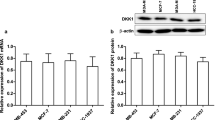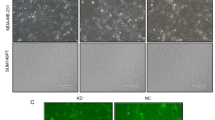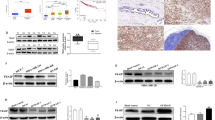Abstract
Breast cancer is a frequent cancer among women. The current study investigated the biological functions of Nek2 in breast cancer and its possible mechanism. The mRNA expression of Nek2 in breast epithelial cells and eight breast cancer cell lines was detected by qRT-PCR. Silencing Nek2 was transfected into MDA-MB-231 and MCF7 cells to examine its roles in the viability, migration, invasion, cell colony, apoptosis and cell cycle of the breast cancer cells by performing CCK-8, wound scratch, Transwell, clone formation and flow cytometry assays, respectively. The expressions of related genes were detected using qRT-PCR and Western blot. MAPK pathway agonist IGF (insulin-like growth factor-1) was added into MDA-MB-231 and MCF7 cells and then cell viability was examined. Nek2 expression was frequently up-regulated in breast cancer cell lines, and silencing Nek2 significantly inhibited the viability, cell migration, invasion and clone formation, promoted cell apoptosis of MDA-MB-231 and MCF7 cells, and arrested cell cycle in G0/G1 phase. Furthermore, knocking down Nek2 decreased the mRNA and protein expressions of Bcl-2, CyclinB1 and CyclinD1, and increased Bax and p27 expressions. Moreover, knocking down Nek2 inhibited the phosphorylation of ERK and p38, and almost completely reversed the expression of p-ERK increased by IGF, but Nek2 knockdown had no obvious effect on p-p38. The inhibitory effect of Nek2 silencing on the cell viability was mainly realized by the inhibition of ERK/MAPK signaling. Nek2 plays an important role in the regulation of the progression of breast cancer in vitro probably through regulating the ERK/MAPK signaling.





Similar content being viewed by others
Data availability
The analyzed data sets generated during the study are available from the corresponding author on reasonable request.
References
Androic I et al (2008) Targeting cyclin B1 inhibits proliferation and sensitizes breast cancer cells to taxol. BMC Cancer 8:391. https://doi.org/10.1186/1471-2407-8-391
Badve SS, Gökmen-Polar Y (2019) Ductal carcinoma in situ of breast: update 2019. Pathology 51:563–569. https://doi.org/10.1016/j.pathol.2019.07.005
Cappello P et al (2014) Role of Nek2 on centrosome duplication and aneuploidy in breast cancer cells. Oncogene 33:2375–2384. https://doi.org/10.1038/onc.2013.183
Cedolini C et al (2014) Type of breast cancer diagnosis, screening, and survival. Clin Breast Cancer 14:235–240. https://doi.org/10.1016/j.clbc.2014.02.004
Cevenini A, Orrù S, Mancini A, Alfieri A, Buono P, Imperlini E (2018) Molecular signatures of the insulin-like growth factor 1-mediated epithelial-mesenchymal transition in breast, lung and gastric cancers. Int J Mol Sci. https://doi.org/10.3390/ijms19082411
Deng L, Sun J, Chen X, Liu L, Wu D (2019) Nek2 augments sorafenib resistance by regulating the ubiquitination and localization of β-catenin in hepatocellular carcinoma. J Exp Clin Cancer Res 38:316. https://doi.org/10.1186/s13046-019-1311-z
Eblen ST (2018) Extracellular-regulated kinases: signaling from Ras to ERK substrates to control biological outcomes. Adv Cancer Res 138:99–142. https://doi.org/10.1016/bs.acr.2018.02.004
Fahad Ullah M (2019) Breast cancer: current perspectives on the disease status. Adv Exp Med Biol 1152:51–64. https://doi.org/10.1007/978-3-030-20301-6_4
Fan WD, Chen T, Liu PJ (2019) NIMA related kinase 2 promotes gastric cancer cell proliferation via ERK/MAPK signaling. World J Gastroenterol 25:2898–2910. https://doi.org/10.3748/wjg.v25.i23.2898
Fisusi FA, Akala EO (2019) Drug combinations in breast cancer therapy. Pharm Nanotechnol 7:3–23. https://doi.org/10.2174/2211738507666190122111224
Fry AM, Schultz SJ, Bartek J, Nigg EA (1995) Substrate specificity and cell cycle regulation of the Nek2 protein kinase, a potential human homolog of the mitotic regulator NIMA of Aspergillus nidulans. J Biol Chem 270:12899–12905
Guo YJ, Pan WW, Liu SB, Shen ZF, Xu Y, Hu LL (2020) ERK/MAPK signalling pathway and tumorigenesis. Exp Ther Med 19:1997–2007. https://doi.org/10.3892/etm.2020.8454
Harrison Pitner MK, Saavedra HI (2013) Cdk4 and nek2 signal binucleation and centrosome amplification in a her2+ breast cancer model. PLoS ONE 8:e65971. https://doi.org/10.1371/journal.pone.0065971
Hayward DG, Clarke RB, Faragher AJ, Pillai MR, Hagan IM, Fry AM (2004) The centrosomal kinase Nek2 displays elevated levels of protein expression in human breast cancer. Cancer Res 64:7370–7376. https://doi.org/10.1158/0008-5472.can-04-0960
Heuser VD et al (2018) Formin proteins FHOD1 and INF2 in triple-negative breast cancer: association with basal markers and functional activities. Breast Cancer Basic Clin Res 12:1178223418792247. https://doi.org/10.1177/1178223418792247
Holliday DL, Speirs V (2011) Choosing the right cell line for breast cancer research. Breast Cancer Res 13:215. https://doi.org/10.1186/bcr2889
Jonkman JE, Cathcart JA, Xu F, Bartolini ME, Amon JE, Stevens KM, Colarusso P (2014) An introduction to the wound healing assay using live-cell microscopy. Cell Adhes Migr 8:440–451. https://doi.org/10.4161/cam.36224
Kazazian K et al (2017) Plk4 promotes cancer invasion and metastasis through Arp2/3 complex regulation of the actin cytoskeleton. Cancer Res 77:434–447. https://doi.org/10.1158/0008-5472.can-16-2060
Kokuryo T et al (2016) Nek2 siRNA therapy using a portal venous port-catheter system for liver metastasis in pancreatic cancer. Cancer Sci 107:1315–1320. https://doi.org/10.1111/cas.12993
Kokuryo T, Yokoyama Y, Yamaguchi J, Tsunoda N, Ebata T, Nagino M (2019) NEK2 is an effective target for cancer therapy with potential to induce regression of multiple human malignancies. Anticancer Res 39:2251–2258. https://doi.org/10.21873/anticanres.13341
Kong Y et al (2016) Platycodin D, a metabolite of Platycodin grandiflorum, inhibits highly metastatic MDA-MB-231 breast cancer growth in vitro and in vivo by targeting the MDM2 oncogene. Oncol Rep 36:1447–1456. https://doi.org/10.3892/or.2016.4935
Lai XB et al (2017) NIMA-related kinase 2 regulates hepatocellular carcinoma cell growth and proliferation. Oncol Lett 13:1587–1594. https://doi.org/10.3892/ol.2017.5618
Li JJ, Li SA (2006) Mitotic kinases: the key to duplication, segregation, and cytokinesis errors, chromosomal instability, and oncogenesis. Pharmacol Ther 111:974–984. https://doi.org/10.1016/j.pharmthera.2006.02.006
Li Y et al (2019) NEK2 promotes proliferation, migration and tumor growth of gastric cancer cells via regulating KDM5B/H3K4me3. Am J Cancer Res 9:2364–2378
Liu B, Qi X, Zhang X, Gao D, Fang K, Guo Z, Li L (2018) Med19 is involved in chemoresistance by mediating autophagy through HMGB1 in breast cancer. J Cell Biochem. https://doi.org/10.1002/jcb.27406
Liu XL, Liu HM, Han N, Li FH, Sun F, Fan DM, Xu Q (2019) PCAT1 promotes the proliferative and migratory potentials of ovarian cancer via targeting NEK2. Eur Rev Med Pharmacol Sci 23:8239–8248. https://doi.org/10.26355/eurrev_201910_19133
Lorenzoni C, Vilajeliu A, Carrilho C, Castillo P, Barreales S, Ismail MR, Sidat M, Augusto O, Garcia-Basteiro AL, Menendez C, Ordi J (2019) Gynaecological malignancies at a tertiary care centre in Mozambique. Eur J Gynaecol Oncol 40:295–299. https://doi.org/10.12892/ejgo4447.2019
Lu L, Zhai X, Yuan R (2015) Clinical significance and prognostic value of Nek2 protein expression in colon cancer. Int J Clin Exp Pathol 8:15467–15473
Marina M, Saavedra HI (2014) Nek2 and Plk4: prognostic markers, drivers of breast tumorigenesis and drug resistance. Front Biosci (landmark Edition) 19:352–365
Morris NR (1975) Mitotic mutants of Aspergillus nidulans. Genet Res 26:237–254
Ouyang Y et al (2019) CircRNA circPDSS1 promotes the gastric cancer progression by sponging miR-186–5p and modulating NEK2. J Cell Physiol 234:10458–10469. https://doi.org/10.1002/jcp.27714
Peart O (2017) Metastatic breast cancer. Radiol Technol 88:519m–539m
Ramos-García P, Gil-Montoya JA, Scully C, Ayén A, González-Ruiz L, Navarro-Triviño FJ, González-Moles MA (2017) An update on the implications of cyclin D1 in oral carcinogenesis. Oral Dis 23:897–912. https://doi.org/10.1111/odi.12620
Razak NA et al (2019) Cytotoxicity of eupatorin in MCF-7 and MDA-MB-231 human breast cancer cells via cell cycle arrest, anti-angiogenesis and induction of apoptosis. Sci Rep 9:1514. https://doi.org/10.1038/s41598-018-37796-w
Roy A, Banerjee S (2015) p27 and leukemia: cell cycle and beyond. J Cell Physiol 230:504–509. https://doi.org/10.1002/jcp.24819
Schultz SJ, Fry AM, Sutterlin C, Ried T, Nigg EA (1994) Cell cycle-dependent expression of Nek2, a novel human protein kinase related to the NIMA mitotic regulator of Aspergillus nidulans. Cell Growth Differ Mol Biol J Am Assoc Cancer Res 5:625–635
Sdelci S et al (2012) Nek9 phosphorylation of NEDD1/GCP-WD contributes to Plk1 control of gamma-tubulin recruitment to the mitotic centrosome. Curr Biol 22:1516–1523. https://doi.org/10.1016/j.cub.2012.06.027
Shah S, Brock EJ, Jackson RM, Ji K, Boerner JL, Sloane BF, Mattingly RR (2018) Downregulation of Rap1Gap: a switch from DCIS to invasive breast carcinoma via ERK/MAPK activation. Neoplasia (new York, NY) 20:951–963. https://doi.org/10.1016/j.neo.2018.07.002
Siegel RL, Miller KD, Jemal A (2020) Cancer statistics, 2020. CA Cancer J Clin 70:7–30. https://doi.org/10.3322/caac.21590
Suarez-Cabrera C et al (2018) The Ras-related gene ERAS is involved in human and murine breast cancer. Sci Rep 8:13038. https://doi.org/10.1038/s41598-018-31326-4
Takahashi Y et al (2014) Up-regulation of NEK2 by microRNA-128 methylation is associated with poor prognosis in colorectal cancer. Ann Surg Oncol 21:205–212. https://doi.org/10.1245/s10434-013-3264-3
Tchakarska G, Sola B (2020) The double dealing of cyclin D1. Cell Cycle (georgetown, Tex) 19:163–178. https://doi.org/10.1080/15384101.2019.1706903
Tian Q et al (2017) Recent perspectives of management of breast cancer metastasis - an update. J BUON off J Balkan Union Oncol 22:295–300
Tsang JYS, Tse GM (2020) Molecular classification of breast cancer. Adv Anat Pathol 27:27–35. https://doi.org/10.1097/pap.0000000000000232
Wang S et al (2011) Abnormal expression of Nek2 and beta-catenin in breast carcinoma: clinicopathological correlations. Histopathology 59:631–642. https://doi.org/10.1111/j.1365-2559.2011.03941.x
Ward EM et al (2015) Cancer statistics: breast cancer in situ. CA Cancer J Clin 65:481–495. https://doi.org/10.3322/caac.21321
Wen HY, Brogi E (2018) Lobular carcinoma in situ. Surg Pathol Clin 11:123–145. https://doi.org/10.1016/j.path.2017.09.009
Xu T et al (2020) Targeting NEK2 impairs oncogenesis and radioresistance via inhibiting the Wnt1/β-catenin signaling pathway in cervical cancer. J Exp Clin Cancer Res 39:183. https://doi.org/10.1186/s13046-020-01659-y
Ye X, Niu Y, Fang ZY (2005) Correlations of centrosome abnormality and genomic instability to tumor. Ai Zheng = Aizheng = Chin J Cancer 24:1290–1292
Ye L et al (2018) Overexpression of CDCA7 predicts poor prognosis and induces EZH2-mediated progression of Triple-Negative Breast. Cancer Int J Cancer. https://doi.org/10.1002/ijc.31766
Zehra S, Doyle F, Barry M, Walsh S, Kell MR (2020) Health-related quality of life following breast reconstruction compared to total mastectomy and breast-conserving surgery among breast cancer survivors: a systematic review and meta-analysis. Breast Cancer (tokyo, Japan) 27:534–566. https://doi.org/10.1007/s12282-020-01076-1
Zeng YR et al (2015) Overexpression of NIMA-related kinase 2 is associated with progression and poor prognosis of prostate cancer. BMC Urol 15:90. https://doi.org/10.1186/s12894-015-0085-7
Zhang MX et al (2016) Effect of silencing NEK2 on biological behaviors of HepG2 in human hepatoma cells and MAPK signal pathway. Tumour Biol J Int Soc Oncodev Biol Med 37:2023–2035. https://doi.org/10.1007/s13277-015-3993-y
Zhang Y et al (2018) NEK2 promotes hepatocellular carcinoma migration and invasion through modulation of the epithelial-mesenchymal transition. Oncol Rep 39:1023–1033. https://doi.org/10.3892/or.2018.6224
Zhang Y et al (2019) High expression of PRKDC promotes breast cancer cell growth via p38 MAPK signaling and is associated with poor survival. Mol Genet Genom Med 7:e908. https://doi.org/10.1002/mgg3.908
Zhou W et al (2013) NEK2 induces drug resistance mainly through activation of efflux drug pumps and is associated with poor prognosis in myeloma and other cancers. Cancer Cell 23:48–62. https://doi.org/10.1016/j.ccr.2012.12.001
Funding
This work was supported by the Special Research Fund for Central Universities, Peking Union Medical College [Grant No. 3332020026].
Author information
Authors and Affiliations
Contributions
Substantial contributions to conception and design: ZX, MZ. Data acquisition, data analysis and interpretation: XW, JL, GL, KF, XW. Drafting the article or critically revising it for important intellectual content: ZX, MZ. Final approval of the version to be published: All authors. Agreement to be accountable for all aspects of the work in ensuring that questions related to the accuracy or integrity of the work are appropriately investigated and resolved: All authors.
Corresponding author
Ethics declarations
Conflict of interest
The authors declare that they have no competing interests.
Additional information
Publisher's Note
Springer Nature remains neutral with regard to jurisdictional claims in published maps and institutional affiliations.
Rights and permissions
About this article
Cite this article
Xing, Z., Zhang, M., Wang, X. et al. Silencing of Nek2 suppresses the proliferation, migration and invasion and induces apoptosis of breast cancer cells by regulating ERK/MAPK signaling. J Mol Histol 52, 809–821 (2021). https://doi.org/10.1007/s10735-021-09979-9
Received:
Accepted:
Published:
Issue Date:
DOI: https://doi.org/10.1007/s10735-021-09979-9




